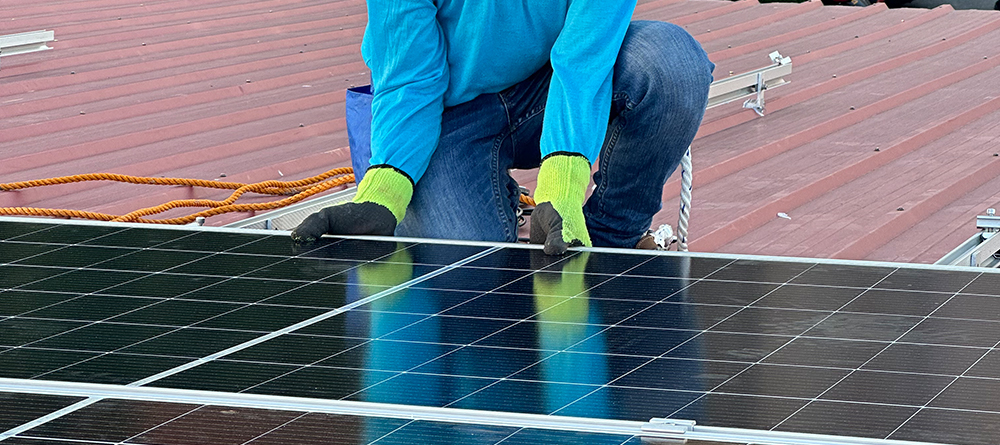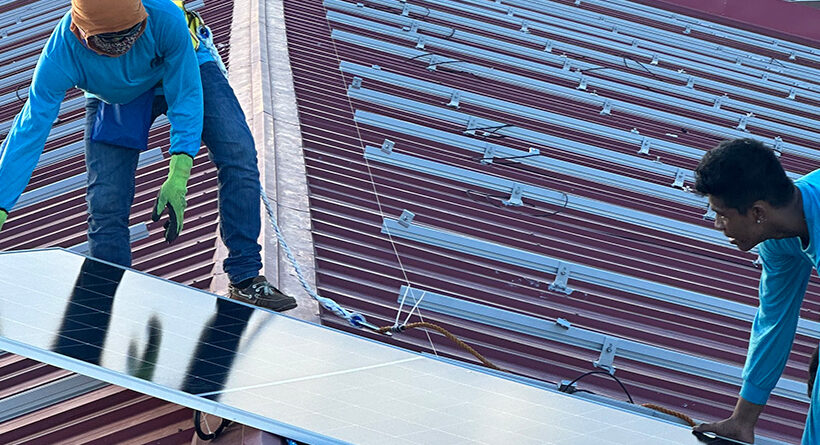Investing in commercial solar panels for manufacturing plants can yield significant financial and environmental benefits. With energy consumption contributing heavily to operating costs and carbon emissions, manufacturing units are increasingly looking to solar power as a sustainable alternative. In this blog, we’ll explore how solar panel installation affects return on investment (ROI) for factories and industrial facilities.
We’ll explain the key concepts, calculate potential savings, and highlight relevant incentives and regulatory frameworks, drawing upon current data in the Philippines. And as always, we at Nativ Techniks are ready to guide you through every step, ensuring your solar installation is optimized for long-term value.
Why Solar Makes Sense for Manufacturing
High Energy Demand in Factories
Manufacturing plants often use heavy machinery, old inefficient HVAC systems, and non-LED lighting, resulting in high daily electricity consumption. Commercial electricity rates and fluctuating peak charges can significantly impact monthly expenses.
Predictable and Stable Energy Costs
Solar panel systems generate power at predictable rates, reducing reliance on grid energy. After the initial investment, fuel costs are essentially zero, making operational budgets more stable and less vulnerable to energy price volatility.
Environmental and Sustainability Goals
Solar installations help manufacturing units meet corporate social responsibility and environmental targets. Reducing grid dependency also means cutting greenhouse gas emissions, helping companies meet both national and international climate commitments.
Calculating Return on Investment (ROI)
Step 1: Determine Installation Costs
Key components include:
- Solar panels (commercial-grade)
- Inverters, mounting structures, wiring
- Project development: feasibility surveys, permits, labor
- Soft costs: engineering, consulting, financing
In the Philippines, a mid-sized commercial system (100–500 kW) may cost between ₱20 million and ₱60 million (₱1 million to ₱1.2 million per 100 kW), depending on technology, importer rates, and site conditions.
Step 2: Estimate Energy Generation
A 250 kW solar array typically generates about 350,000 kWh yearly in the Philippines, assuming a solar insolation average of 4–5 kWh/m²/day and system efficiency of 75%.
Step 3: Calculate Annual Savings
Multiply generation by retail electricity rates (around ₱8–₱10/kWh in industrial zones). So, annual savings for 350,000 kWh would be ₱2.8 million to ₱3.5 million.
Step 4: Factor in Incentives
The Renewable Energy Act offers benefits like:
- Duty-free import of solar components
- Income tax holidays for solar IPPs
- Accelerated depreciation
- Net metering policies up to 100 kW for commercial entities
If applicable, industrial buyers can significantly reduce the upfront costs through these incentives.
Step 5: Calculate Payback Period and ROI
Ignoring financing, payback is:
Payback period = Total cost / Annual net savings
- If a ₱30 million system yields ₱10 million in net savings, payback occurs in about 3 years.
- After that, ongoing cash flows continue for 15–20+ years of expected solar panel life, resulting in IRRs well above typical corporate benchmarks.
Factors That Impact ROI
Solar Resource Quality
High irradiance areas, such as Luzon and Visayas, yield better solar production. Microclimates and shading can reduce output, so rooftop orientation and site selection are crucial.
System Size and Energy Matching
Aligning system capacity with daytime energy usage maximizes self-consumption. Oversizing can mean exporting surplus energy under net metering, which may provide lower compensation, or even go unused if limits are reached.
Electricity Rate Escalation
Utility rates in the Philippines have historically risen at 3-3.5% annually. Solar systems hedge against this increase, strengthening ROI over time.
Performance and Maintenance
Commercial solar panel systems require periodic cleaning, inverter checks, and performance monitoring. Simple annual maintenance can preserve output and sustain ROI.
Financing and Interest Rates
Using debt financing affects ROI. Low-interest loans with grace periods for construction can improve project IRR, while high-rate financing reduces net savings.
Incentives and Support Structures
Net Metering for Commercial Users
The ERC allows net metering up to 100 kW per meter, including commercial and industrial sites. Surplus energy credits can offset grid consumption, lowering utility bills further.
Feed-In Tariffs (FIT) and Renewable Energy Certificates
While FIT is more common for utility-scale systems, commercial-scale solar systems may earn Renewable Energy Certificates (RECs) in voluntary markets, offering additional income.
Tax Incentives and Accelerated Depreciation
Companies can enjoy tax holidays and write off accelerated depreciation on solar equipment, effectively lowering the taxable amount and shortening ROI.
Local Government Support
Some local government units offer municipal incentive packages like streamlined permitting and fee waivers for green or clean energy projects.
Case Example (Hypothetical)
Factory A installs a 300 kW system for ₱36 million:
- Generates 420,000 kWh/year
- Saves ₱3.5 million annually
- After incentives and expenses, the net annual benefit is ₱2.8 million.
- Simple payback in roughly 13 years
- Over a 25-year lifespan, ROI approaches more than 200%
This example illustrates potential ROIs, but real-world results depend on site specifics.
Overcoming Challenges
Upfront Capital
We understand that large commercial systems require significant investment. We help you explore financing options, such as leases, loans, or power purchase agreements (PPAs), to manage costs and preserve capital.
Regulatory and Utility Coordination
Securing approvals from the DOE, ERC, and distribution utility can be complex. We at Nativ Techniks support you through permitting, technical screening, interconnection agreements, meter installations, and compliance inspections, simplifying the process and saving time.
Operational Integration
Manufacturing units typically need to stay on-grid and need reliable power. Proper system design includes PV system management and failsafe islanding measures to ensure seamless integration with ongoing plant operations, keeping production consistent without interruptions.
Performance Assurance
To maintain ROI, panels must deliver expected performance. We provide real-time monitoring systems, performance analysis, and maintenance plans to detect, diagnose, and resolve issues before production is affected, preserving ROI.
Steps to Launch Your Project
- Initial assessment: We’ll evaluate your energy consumption, site conditions, and roof or land suitability.
- Feasibility study: We calculate system potential, estimated cost, incentives, and ROI projections.
- Design and engineering: An optimized system including solar orientation, panel layout, mounting type, and electrical integration.
- Permitting and approvals: Handling all documentation through DOE, ERC, and the distribution utility.
- Installation: Panels, inverters, structures, wiring, safety systems, metering, and performing quality checks throughout.
- Commissioning: Acceptance testing, performance validation, utility interconnection, and system launch.
- Operations and maintenance: Ongoing monitoring, periodic inspections, data reporting, and support to keep the system running at peak efficiency.
Long-Term Benefits Beyond ROI
Stability in Energy Costs
With solar installed, energy costs are steadier. Even if grid prices rise 5% a year, your solar-generated energy effectively hedges those increases.
Enhanced Corporate Profile
Sustainability and clean energy are increasingly valued by customers, investors, and supply chains. A proactive solar investment can bolster brand image and support ESG targets.
Improved Resilience and Grid Support
During peak daytime demand, solar output helps reduce strain on the grid. In some cases, pairing solar with storage increases resilience and may qualify for grid support or demand-response programs.
Increased Property Value
Solar-equipped industrial sites are more valuable, given ongoing energy savings and sustainability credentials. It’s an asset enhancement that can support balance sheets and financing.
Nativ Techniks: Your Solar Partner
- We design and install custom commercial solar panel systems to match your plant’s energy profile.
- We may assist with permit applications, DOE/ERC approvals, utility coordination, and meter commissioning, minimizing your effort and accelerating timelines.
- We also offer performance monitoring and operations support to optimize output and protect your ROI over the system’s life.
Tips to Improve ROI
- Opt for high-efficiency panels and top-tier inverters—higher upfront cost but better performance long term.
- Align solar generation with your peak load periods to maximize self-consumption.
- Explore power purchase agreements (PPAs) if capital investment is a barrier.
- Consider Energy storage to shift daytime solar generation to night-time manufacturing operations or to provide backup.
- Regularly track bills and meter readings to confirm credit application accuracy and system performance.
Future of Solar in Philippine Manufacturing
Larger Net Metering Limits
Proposals aim to increase allowable net metering capacity beyond 100 kW, giving industrial plants more flexibility.
Virtual and Group Net Metering
Shared solar systems across industrial parks or multiple meters can optimize utilization and ROI collectively.
Battery Incentives
With storage-friendly policies emerging, combining solar with batteries can enhance value, especially in time-of-use tariff environments or industrial demand charge scenarios.
Energy Credit Markets
Companies may be able to trade RECs or solar-generated credits on marketplaces, adding revenue streams to the bottom line.
Conclusion
Calculating and understanding ROI is essential for manufacturing units considering solar panel installation. By evaluating installation costs, estimated production, incentives, and grid offset potential, you can recognize how fast payback happens and the long-term value solar brings. With rising electricity rates and national efforts to reduce environmental impact, the Philippines is a favorable environment for commercial solar initiatives.
We at Nativ Techniks are equipped to support you from initial feasibility to full deployment, and beyond, ensuring that your solar investment delivers maximum ROI, operational reliability, and corporate sustainability. If you’re ready to explore solar for your plant, reach out, and let’s power your progress sustainably.
Contact us to know more and get the best panel for your needs. To call, dial +639176310032 or write to us directly at wecare@nativtechniks.com




Leave a Reply